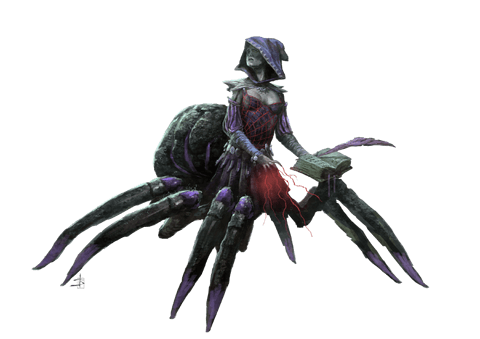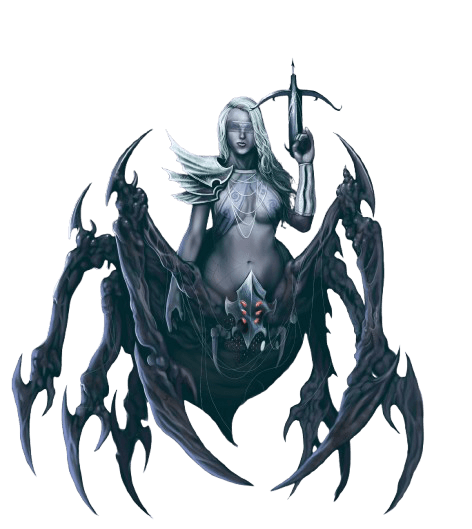Playing a Drider: Unlikely Heroes in After the Fall

When Holoth fell and the Coalition seized control, the power structure of the drow shattered — but the driders, outcasts of their former society, endured. These spider-bodied beings, once condemned to exile and torment, now find themselves in a unique position of influence and uncertainty. No longer bound by the rigid hierarchies of pre-Fall drow society, some driders embrace newfound autonomy — while others descend into madness, or worse. Playing a drider in this era means confronting fear, forging a new path, and deciding whether to rise above the curse — or embrace it.
In Rise of the Drow: After the Fall, playing a drider offers a rare chance to explore themes of transformation, survival, and reclaimed agency. These beings are not mere monsters — they are former drow whose transformations carry deep cultural, spiritual, and emotional scars. Whether they now act as allies, enemies, or something far more complicated, driders represent a force players must carefully consider.
Want more about character creation in After the Fall? Explore Drow Party Dynamics.
Looking for drow house info? Check out the Drow Houses of Holoth.
Want to play a drow? Read the Meet the Captives: Playing a Drow in After the Fall.
The Origins of the Driders: Naraneus’s Cursed Legacy

Driders were once drow — failed supplicants of Naraneus, the Spider Queen. Those who faltered in her service were transformed into grotesque half-spider forms, cursed to wander the Underdark in disgrace. Once they were elite warriors, casters, and priestesses. Eventually, they became feared, ostracized, and hunted.
However, with Naraneus’s withdrawal during the Venomtide and the collapse of House Gullion, the divine leash has been severed. While some driders remain mentally broken — trapped in their curse and driven by madness — others have reclaimed agency and purpose.
Playing a Drider After the Fall: Hunters, Rebels, Survivors
The fall of Holoth fractured the boundaries that once defined drow society. Toxic energies seeped from the Demi-plane of Venom into the Prime Material Plane, warping parts of the ruined city — and those who lived near them. Amid these afflicted areas, many driders have established twisted enclaves. They have mutated further due to the venomous effluence and now operate without the constraints of traditional drow expectations.
Driders are no longer merely pariahs. Some have become warriors. Others act as schemers. Many now exist as nomads, hunters, or even Coalition enforcers. Their motives differ greatly, making them an exciting faction to explore in any campaign.
Types of Driders in Hopeholme

The Failed — Still bound to their curse, these driders prowl the darkest corners of Hopeholme. They are feral, fragmented, and dangerous — more beast than drow. Yet their aggression masks pain and torment.
The Arach’tsala — More focused and intelligent, the Arach’tsala are driders who cast off their loyalty to Naraneus and seek new paths to power. Some loosely align with House Darzijon or other factions. Others strive to create a new society entirely — one where driders lead.
Coalition Servants — In rare and disturbing cases, the Coalition has recruited driders into their ranks. These individuals may act as hunters, guards, or enforcers, rewarded with autonomy in exchange for brutal loyalty.
Wanderers and Nomads — Not all driders seek power. Some roam the fringes of the Underworld, becoming scouts, mercenaries, or reluctant guides. Others retreat into solitude, hunting alone or protecting ruined shrines to long-forgotten gods.
Playing a Drider: Character Options and Challenges
Playing a drider in After the Fall is a thrilling and dramatic experience. However, it comes with unique narrative and mechanical implications:
- No House Background — Unlike drow, driders do not gain the benefits of a House Background. Joining a House must be earned in-game and can serve as a rich roleplaying arc.
- Increased Power, Increased Burden — Driders are more powerful than drow but suffer from social stigma. Their monstrous forms make covert operations harder, and their presence often incites fear — even among allies.
- Redemption or Ruin — Whether striving to regain their place in society or fully embracing their transformation, a drider character must contend with legacy, identity, and perception.
Drider characters often face conflicting loyalties — former houses, new alliances, personal vendettas, and even haunting dreams left by Naraneus. As a player, you’ll decide whether your character rises above their curse — or embraces it.
Playing a Drider in Roleplay: Ideas for Game Masters

Use driders to create intrigue, conflict, and unexpected alliances:
- A drider NPC offers crucial information — but demands a secret relic from the ruins of Tolgorith Tower in return.
- A former priestess-turned-drider seeks redemption through battle, hoping to defend the drow against the Coalition and earn a second chance.
- An enemy Coalition patrol is revealed to be led by a cunning drider officer who once served House Gullion.
- A player character drider receives a mysterious summons from the Arach’tsala — is it a trap, or the beginning of a rebellion?
The Driders’ Web of Fate
Driders in After the Fall are no longer cursed footnotes in drow society. They are symbols of transformation — both horrific and liberating — and their role in the future of Hopeholme is uncertain.
They may rise as unlikely allies. Others could fall as twisted monsters. Still, a few might become something else entirely.
The choice is yours — and the web is already spinning.

Rise of the Drow: After the Fall 🕷️
The City Has Fallen — Will You Rebuild, Rebel, or Rule?
The mighty drow city of Holoth lies in ruin, its elegant towers shattered, its streets filled with conflict and opportunity. The Coalition’s brutal occupation tightens its grip, but beneath the watchful eyes of their guards, power shifts in the shadows.
You are drow. Now is your chance to take the power back.
Darkness Rises, and the Time is Now…
Align with House AAW and be the first to uncover new quests, ancient powers, and revelations from the Underworld.



